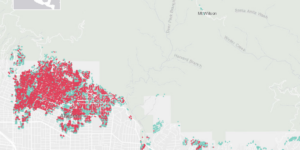Claims that involve physical or mental injuries that arise over time from repetitive stress, motion or exposures, also known as cumulative trauma (CT) claims, make up nearly half of litigated claims in the Los Angeles basin area according to the California Workers’ Compensation Institute (CWCI).
The new study, based on a sample of 1.4 million California work injury claims with 2010 to 2022 carrier notice dates, examined the growth of CT claims as a share of litigated claims in the California workers compensation system.
Statewide, CT claims increased from 29.4 percent to 37.5 percent of all litigated claims over the 13-year study period.
Regional results revealed that over that same period, CT claims’ share of all litigated claims was fairly stable in Northern California and the Central Valley, but increased in 2022, while in Southern California CT claims’ share of the litigated claims increased steadily throughout the period.
The sharpest increase was in the Inland Empire/Orange County, according to the study, where CT claims jumped from 30.2 percent of the litigated claims in 2010 to 40.6 percent in 2022, slightly more than the increase in Los Angeles County, where CT claims went from 38.6 percent to 48.7 percent of the litigated claims, and San Diego where CT claims increased from 25 percent of the litigated claims to 33.4 percent.
A regression analysis, controlling for the influence of other variables, indicated the differences between the regions were only partially explained by differences in other underlying claim characteristics.
Other than regional factors, differences in tenure had the strongest impact on differential CT rates, the study found.
Employees with less than a year of tenure at the time of injury had a much lower CT rate (26 percent) than more tenured workers, as CT rates increased incrementally as tenure increased, climbing as high as 49 percent among workers with more than 10 years on the job.
A review of the CT rates across nine major industry sectors showed that CT claims were most prevalent in the manufacturing sector, where they accounted for nearly half (48.8 percent) of the litigated claims, which was almost twice the proportion noted in the construction sector.
The food service sector had the second highest CT rate, with 46.9 percent of the claims in this sector involving CT injuries, while the agriculture sector had the lowest CT rate (24.2 percent).
Regression analysis showed that while the type of industry influences CT rates, for most sectors other factors such as region and job tenure play a comparable role.
Workers under the age of 30 had a somewhat lower CT rate (28.3 percent) than workers who are over 30, whose CT rates ranged from 35.1 percent to 38.8 percent, though more than a third of all CT claims in the study involved injured workers who were under 40.
Regression analysis showed that age is not a strong predictor of CT rates compared to other factors, the CWIC study found.
CT rates were much higher for workers at the lower end of the wage scale, with CT rates of 40 percent for workers making less than $300 per week and 42.1 percent for those earning $300 to $599 per week.
Workers making more than $900 per week all had similar CT rates, with CT claims representing between 30 percent and 31.7 percent of their litigated claims.
“As with age, regression analysis showed that the employee’s average weekly wage is not a strong predictor of CT rates compared to other factors,” the study stated.
CWCI’s analysis of CT claims has been published in a Research Note, “Cumulative Trauma and Litigated Claims in the California Workers’ Compensation System.”





















 Leading Insurance Innovation in the AI Age (Part 1: Culture)
Leading Insurance Innovation in the AI Age (Part 1: Culture)  2025 Underwriting Profit and ‘Shop-a-Palooza’ Predicted for Auto Insurance
2025 Underwriting Profit and ‘Shop-a-Palooza’ Predicted for Auto Insurance  Los Angeles Fires Become Existential Test for California’s Stopgap Insurer
Los Angeles Fires Become Existential Test for California’s Stopgap Insurer  Empowering the ‘Semi-Captive’ Agent: A New Playbook for Insurers
Empowering the ‘Semi-Captive’ Agent: A New Playbook for Insurers 